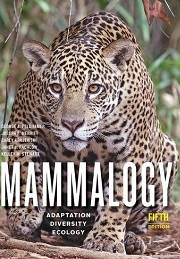Mammalogy: Adaptation, Diversity, Ecology (Fifth Edition)

George A Feldhamer, Joseph F Merritt, Carey Krajewski, Janet L Rachlow and Kelley M Stewart
John Hopkins University Press, £92.50
Since this popular textbook’s fourth edition was published in 2015 around a further one thousand mammal species have been identified, bringing the current known total to nearly 6,500. This increase provides some evidence of the great interest that the Mammalia hold for us. Apart from us being intrigued by our closest relatives, mammalogy – the study of mammals – is integral to modern biology.
These animals play vital roles in so many ecosystems, acting as “keystone species, ecosystem engineers, or mutualists that impact biotic communities to a greater extent than predicted by their numbers”.
Mammals are incredibly diverse compared with the other vertebrate classes, demonstrating an impressive range of structures, physiologies, behaviours and distributions, despite their relatively low species count. They are also valuable to humans in agriculture, in medical research and as companions, not forgetting the significance of the threat some pose as reservoirs for zoonotic diseases.
This is a large tome in both physical size (over 700 pages) and in scope, although the authors strike a healthy balance between breadth and depth. Split into five main sections, the book covers evolution and phylogeny; movement and support, feeding and reproduction; adaptive radiation and diversity; behaviour and ecology; and zoonoses and conservation.
Attractively presented, accessibly written and laid out, Mammalogy is also very well illustrated, not only with numerous monochrome photographs and other illustrations but, for the first time with this edition, many full-colour photographs too.
Although it is aimed at upper undergraduate or graduate courses, I defy anyone with an interest in biology or the world around them not to flick through this and find numerous points of interest.
Mike Smith FRSB


